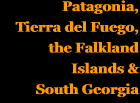|
...and 856 new wagons and coaches!

Converted metre gauge stock
A few of the FCCC's metre gauged vehicles were suitable for re-use on the narrower gauge. Inevitably they tended to be the smaller items of rolling stock. First class cars no. 2 & 3 of 1886, and second class car no. 4 by Brown, Marshall also in 1886 were modified. These were apparently the smallest of the metre gauge passenger coaches.
Other older vehicles were moth-balled after the end of the metre gauge in 1931. As with the locomotives, there seemed to be no urgency in getting rid of them. The two Metropolitan A. R. Carriage & Wagon built coaches of 1909 and 1915 were recorded in the Estadistica as still stored in 1940, along with 25 open wagons also from Metropolitan ARCW.
New 75cm gauge vehicles
The original invitation to tender for 75cm gauge rolling stock required that 100 vans and passenger cars be supplied, together with 650 goods vehicles (1). The requirements were for 50 furgons (baggage or brake vans), 25 first class cars and 25 second class. For the carriage of cargo there was a need for150 flats, 150 high-sided or gondolas, 100 boxcars, 100 cattle cars, 100 sheep cars and 25 each of water and oil tanks. Eight companies or combines tendered for one or other of the contracts (). Eventually both went to a Belgian company, the 'Societe Anonyme des Ateliers de Construction de et a Familleureux Belgique'. There was some negotiating over the financial terms and in fact the order must have been increased, for in 1923 a government report (2) stated that 856 vehicles had been purchased for the FCCC at a total cost of 2,258,346.85 pesos (roughly £20,000 at the current rate of exchange, or £235 per vehicle). There have always been rumours in the area that the Familleureux stock was surplus after the First World War and that the gauge of 75cm had been chosen for Patagonia precisely so that the rolling stock could be purchased cheaply. However, there is no evidence to support this idea.
The new rolling stock was of bogie construction with steel underframes and wooden bodywork. Each vehicle carried an oval aluminium maker's plate on the solebars, and also a numberplate.
The standard Familleureux aluminium maker's plate, unusually without 90 years' worth of paint.
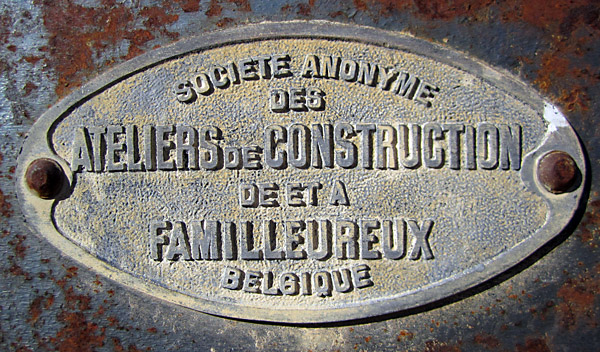
As mentioned above there was a variety of goods vehicles. As well as the types of car specified in the invitation to tender, the deliveries included some extra long10m flats or 'plataformas'. The cattle and sheep cars were of the usual Argentine style with end doors enabling stock to be loaded along the length of the train. Passenger stock included 1st and 2nd class carriages with end balconies and wood burning stoves in each saloon, and two types of brake van or caboose, known as 'furgons' .
Coaches and 'furgons' etc. seem to have been numbered in the 1000 series, vans from 2001, high-sided opens from 3001, low-sided/flats from 4001, with longer ones from 4191, 'hacienda' wagons (livestock) from 5001 (one floor) and from 6001 (two floor), oil tanks from 7001 and water tanks from 7500.
The original invitations to tender specified that delivery was to be to San Antonio Oeste, Comodoro Rivadavia and Puerto Deseado, but in the event the vehicles were delivered to stockpiles at San Antonio and Puerto Madryn. Vehicle allocation lists from the various lines in 1945 are at the foot of the page. These give some dimensions and weights.
Photos of each type of vehicle

Furgones, effectively brake and parcels vans in British terminology (4).
There were two varieties of these, though numbered in the same 1000 series. The 'Furgon cargas' had a sliding side door and a low curved roof, as shown in the upper picture. The 'furgon pasageros' on the other hand (seen in the lower photo) had the higher passenger coach style roof, and only a single hinged door in each side.
The shape above the number (of a vacuum cylinder) shows that the vehicle is fitted with a vacuum brake.
Both were mounted of passenger type bogies, but the 'Furgon pasageros' were rather heavier.
|
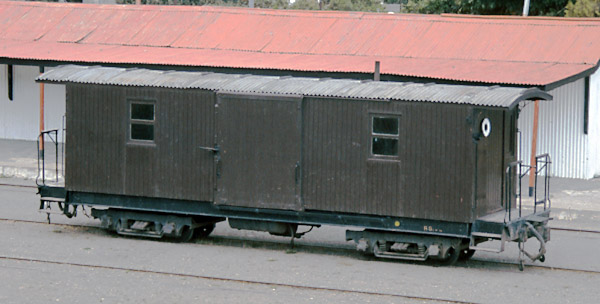
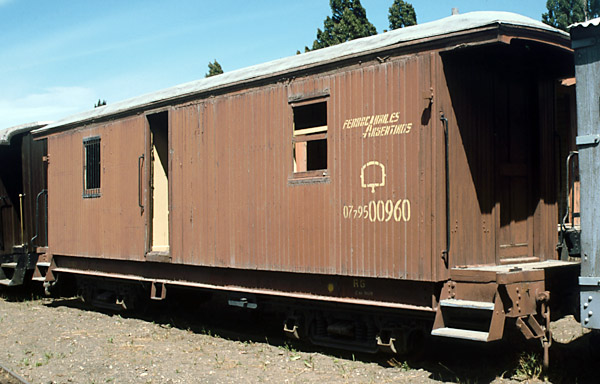
|
First Class passenger car
Series 1101 up to 1125. They had leather upholstered seats originally, a lavatory (of the hole in the floor variety) and outside could be distinguished by having windows set in pairs.
The upper photo shows five pairs of windows and a blank wall at this end where the vestibule and wash-basin were located. The second photo (taken at Rio Gallegos) shows the opposite side. The window pattern is different, there being a single window at the far end lighting the lavatory and then the paired pattern of windows but broken by a blank wall in the centre where the wood stove is located.
|
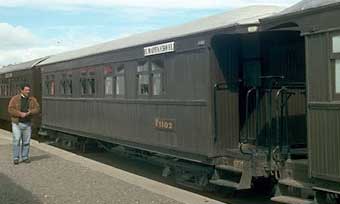
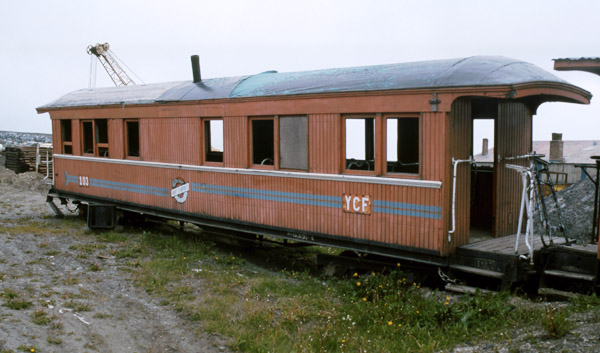
|

Second Class Passenger Car.
Series 1201 up to 1225. Second class cars have plain wooden seats and from outside can be seen to have a continuous line of windows from end to end.
The upper photo shows the continuous window line and the higher curve to the roof found on passenger stock. The far left hand window is for the lavatory compartment. The second photo is of the opposite side. The blank wall in the centre is for the stove whilst that at this end is for the vestibule and basin.
|
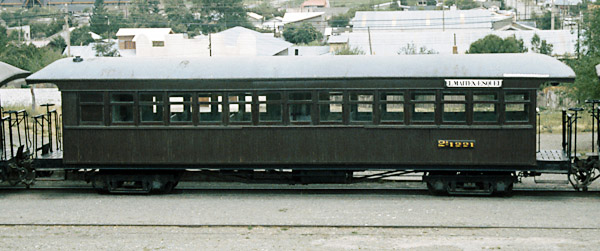
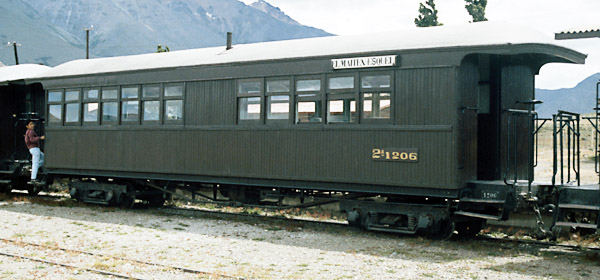
|
Passenger coach details
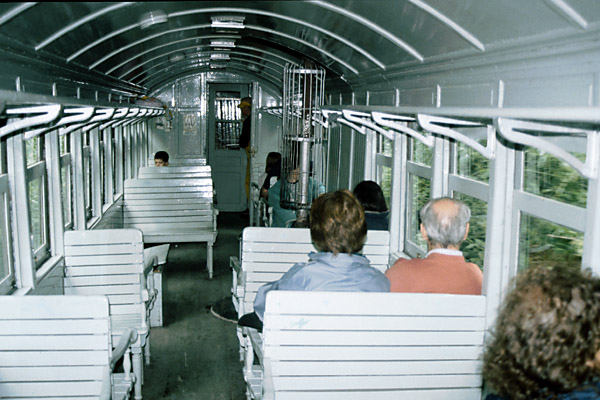
These photos show a variety of passenger car details, including end and interior views, the basin and lavatory, a notice prohibiting travel on the end platform, and a train destination indicator board.
The sink is clearly a replacement carried out after nationalization of the English railways as it bears the FCS monogram.
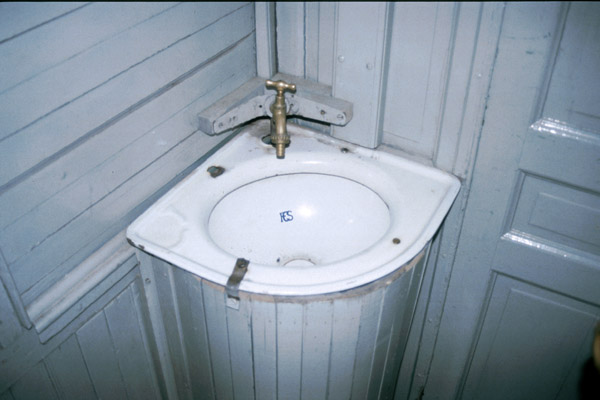
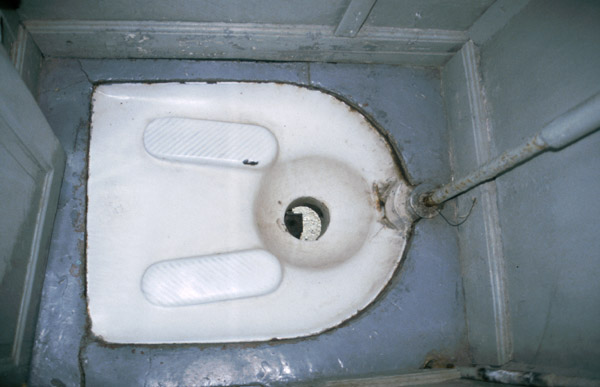

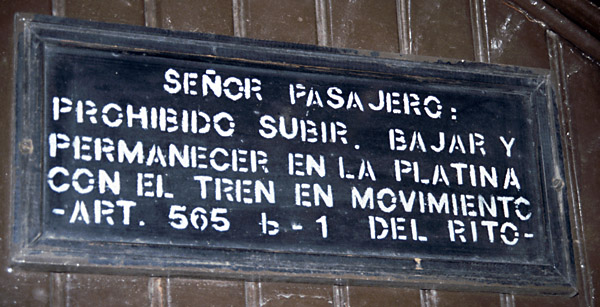
A typical passenger car stove, and the view from one coach to another across the open balconies.
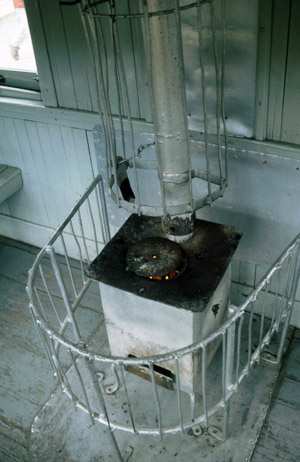 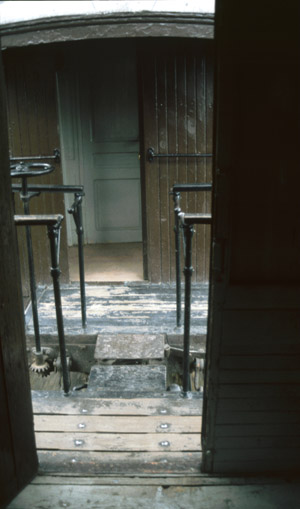
An end view of a passenger coach in which a number of points may be made:
• The door in to the coach is off centre to suit the two by one seating inside.
• The hand brake wheel at the left of the balcony operates through bevel gearing on to a rod passing through the headstock.
• The knuckle coupling has a slot and hole for a pin thus permitting its use with a link-and-pin coupling.
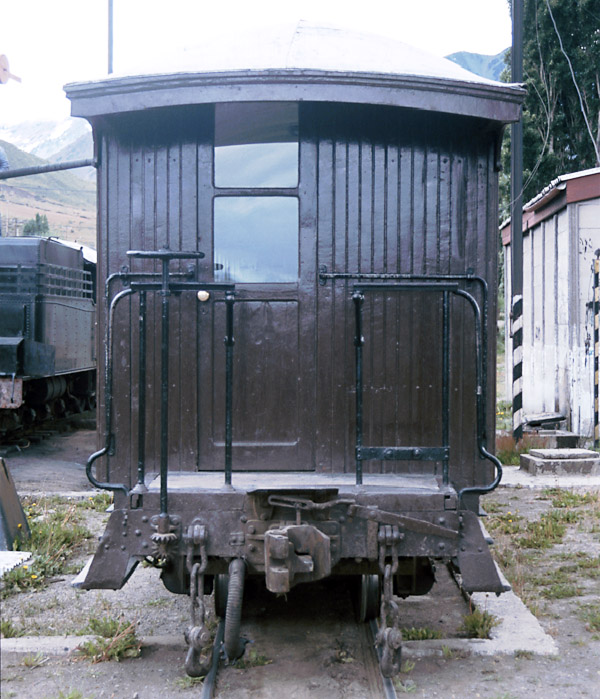
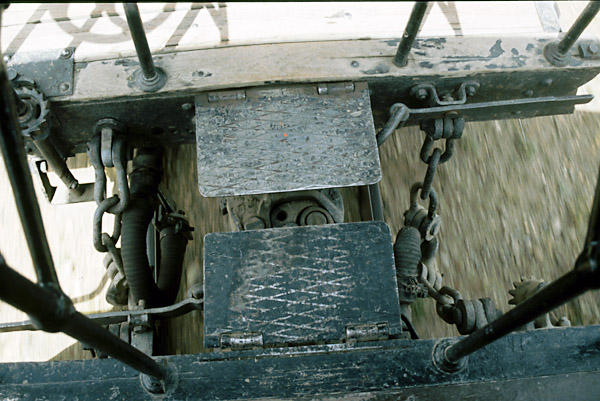
|

Van or boxcar, ‘Cubierto'.
Series 2001.
The running numbers on some of these photos are recent ones, on the Esquel line, and may be different from the originals.
|
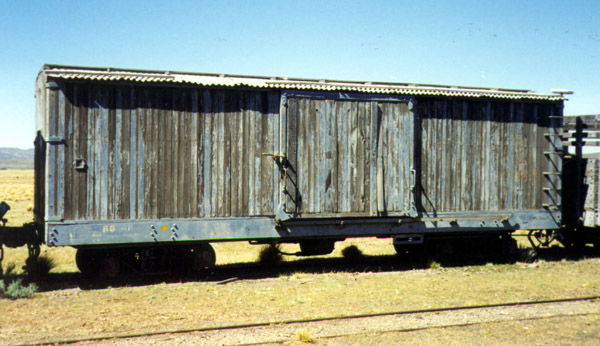
|

A high-sided open wagon,
Series 3001. Known as 'bordes altos' and used mainly for carrying bales of wool, sometimes with tarpaulins over the top.
|
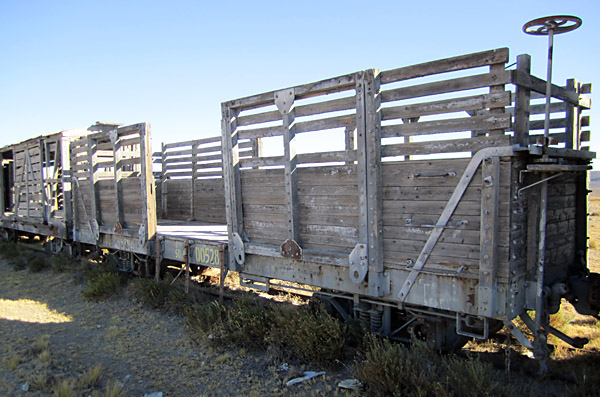
|
A five plank open wagon.
Series 4001, Normally known as 'plataformas'.
|
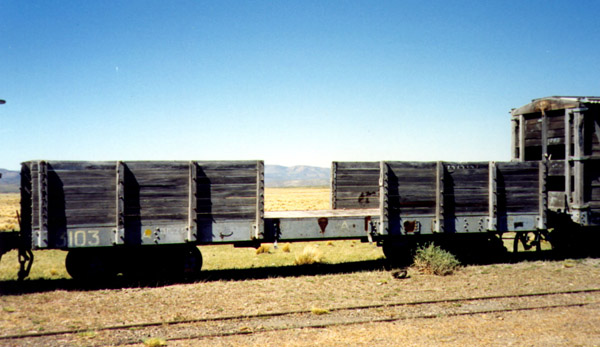
|

10 metre 'plataformas'
There were a smaller number of flat or low-sided wagons built to a 10 metre length rather than the usual 7.8m. These were numbered from 4151. The photo shows a normal length chassis loaded on one of the 10m wagons and thus illustrating the length difference.
|
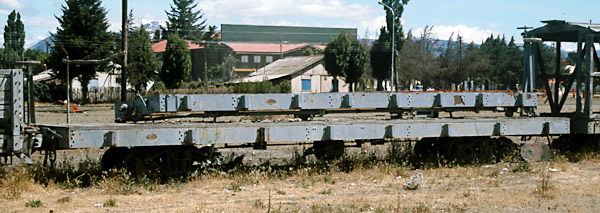
|

A cattle van with end loading doors.
Series 5001 single deck.
|
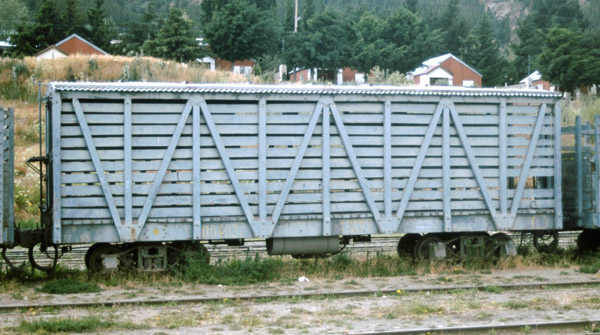
|
Double-deck livestock van for sheep
There were also double-deck sheep cars, as on many Argentine lines
These were in the 6001 series. They can be identified from the outside by the waist height horizontal bar and the framework mounted on top of the chassis rather than outside it.
An inside view along a pair of derelict double-deck 'Hacienda' cars shows how the open end doors created a gangway for the sheep right through the train. This was much quicker than loading each car separately. The floors were surfaced with a grid of wooden strips to reduce the likelihood of feet slipping. The second floor was removeable, resting on long strips of angle iron at waist height. These extra floors have long since disappeared, and some staff on the Esquel line are not even aware that they existed.
|
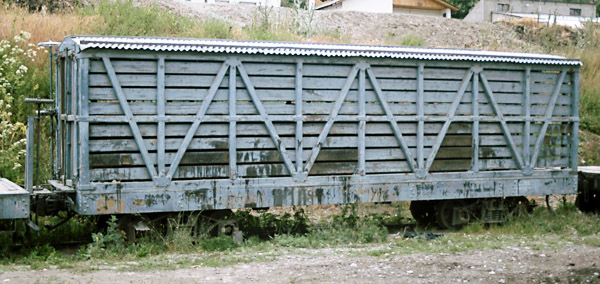
A large number of these double-deck sheep carriers have been converted into conventional vans, by the addition of sliding side doors and the blocking up of the end doors and the ventilation slits. This may have been because there was a shortage of livestock traffic, but may also have been owing to some fault in the vehicles as originally designed. One can't help feeling that the double-deckers would have been very difficult to clean and that the angle iron supporting brackets might have been less than secure if there was any flexing in the bodywork. The removeable floors would have been very heavy if they were strong enough to bear the weight of a full load of sheep.
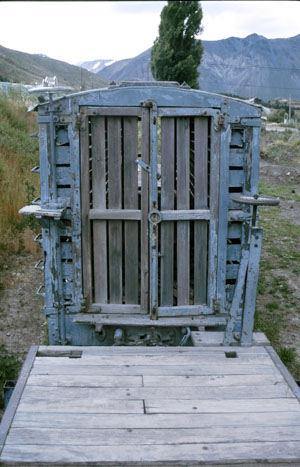 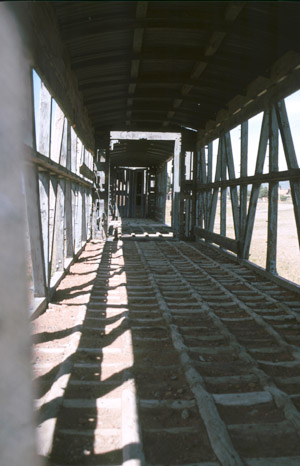
|

A tank wagon,
Series 7001 for oil, though series 7500 for water were identical.
Note the different frame, with the longitudinal members having the flanges facing outwards.
|
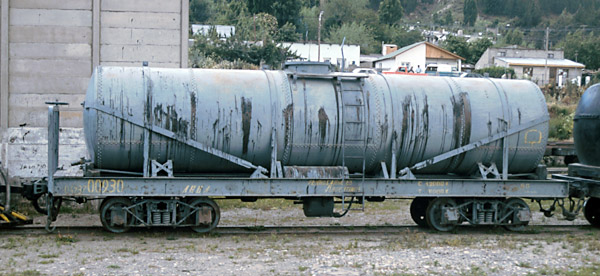
|
Bogies/Trucks
Two types of bogie were used - a standard diamond/archbar design for freight stock, and a heavier, better-sprung design for furgons and passenger cars.
A freight wagon diamond bogie.
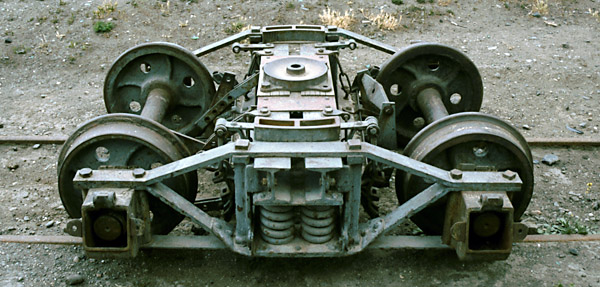
Next is a damaged passenger type bogie, missing its coil springs.
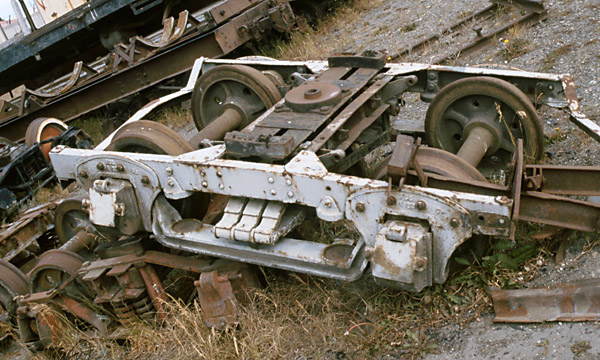
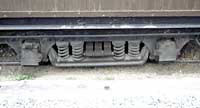 A variation on this is shown below left where four primary springs are fitted instead of two, one of them coiled the opposite way and probably from a freight car! A variation on this is shown below left where four primary springs are fitted instead of two, one of them coiled the opposite way and probably from a freight car!
Brakes and couplings
All stock was vacuum braked. Couplings seem have been Janney/MCB style automatic couplers right from the start, although it seems likely that this was an afterthought in the design for side chains are also fitted. Whilst it is possible that an earlier coupler style was intended when the vehicles were ordered no sign of any old coupling has ever been seen. The photo of a Henschel 2-8-2 at General Vintter in 1937 however, appears to have a long coupling link extending out over the cowcatcher (pilot). This may be a relic of the original system.
The photo shows the central automatic coupler, and the side-chains. The vacuum pipe is on the left and the release lever for the coupling extends out to the right. Whilst the side chains may be surplus to requirements, David Eggleston comments that he was grateful for them on a journey in October 2000 when a coupling parted at 25mph near El Maiten!
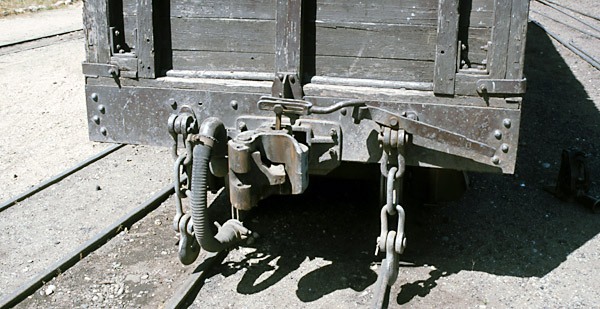
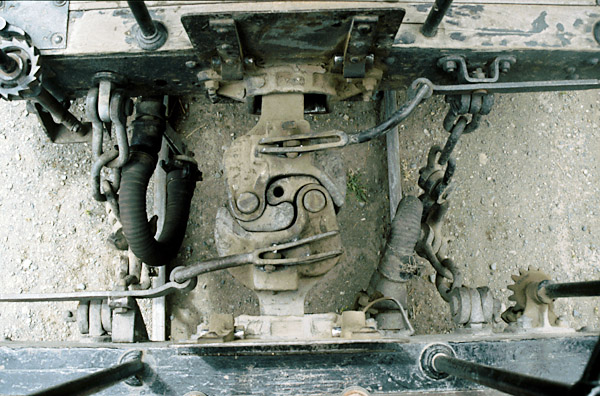
Maintenance and new construction
The workshops were at Puerto Madryn. These were capable not only of major overhauls of FCCC rolling stock but also of building new railcars for the 75cm lines and for the broad gauge routes from Comodoro Rivadavia and Puerto Deseado.
Señor Peter Seibt who worked there in the 1950s recalls that much of the work resulted from the flexing of the wooden bodywork in use (8, page 227). It may be surmised that wooden frameworks built in Belgium might well have had a lot more play in them in the dry Patagonian climate. In fact some doubts about the construction of the rolling stock had been raised early on. As Dr. Perez comments: "Overall, the 75cm material is good, but there are faults visible to a casual eye... I cite, for example, the length of the continuous vacuum brake hoses, which are too short to couple up and it is necessary to use a supplementary length. In general the wood has been placed with so much lack of fastening at the time of assembly of the wagons that the gaps in the floors are more than 3 centimetres wide. In the passenger coaches the material used has been so green that, on being hauled, there is movement in the woodwork clearly visible to the eye."(9)
Whilst the original construction was largely in oak, this was not available in Argentina. Repairs were therefore in quebracho, quebracho blanco, curupay or incienzo for the floors, in incienzo for the structures, in Parana pine for planking, and in cedar or nogal tucumano for furniture.
Use and dispersal of stock
There was far more stock than could be used on the single 150 mile line that was originally built, or even on the Esquel line when that was eventually completed. Much of the surplus disappeared over the years to the other lines in Chubut, Rio Negro and Santa Cruz provinces. Detailed lists and allocations of the 1922 rolling stock are available in Appendix 14.
References:
1 Details of the tenders received are in Review of the River Plate, 3rd March 1922 pp531-35, 24 March 1922 pp723-5, 18 Aug 1922.
2 Information contained in Situación Financiera de los Ferrocarriles del Estado. Informe Presentado al Poder Ejecutivo por el Administrador General, Dr. Enrique S. Perez. 18 Nov. 1924. Table no. 8 containing information on locos purchesd for the FC Central del Chubut. Data kindly forwarded by S. Damus.
3 Narrow Gauge Rails to Esquel, Keith Taylorson, Plateway Press, 23 Hanover St., Brighton, BN2 2ST, UK, 1999.
4 Freight stock photos by Keith Taylorson, David Sinclair and Martin Coombs.
5 Passenger stock photos provided by David Sinclair and Martin Coombs.
6 Coach interior photo by Andy Kirkham.
7
8 Anecdotes published in Los Ferroviarios que perdimos el Tren. V. Accorinti et al.
9 The State Railways Patagonic Lines, a report by the Administrator General of the State Railways, Dr Enrique S. Perez, May 1925.
3-9-11
|
|

